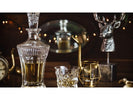
How Long Can You Leave Alcohol In A Crystal Decanter?


Before glasses were made, the ancient people used what they had to make vessels for their drinks. People came with the most innovative materials they have at the time, such as wood, stone, pewter, ceramics, etc. As knowledge progressed, men became more inventive until the Venetians started using the lead crystal to make glasses and other liquor vessels.
Like how diamonds are crafted, crystal glasses also get their luster and shine from the polishing and are further enhanced by cutting. The intricate cuttings on the crystal vessels are more than decorative - they improve the crystal’s brilliance and luster.
Although it is not a secret how crystal decanters make your drinks and bar counter look more elegant, users always question how long alcohol should be left in these containers. Let’s find out.
In the olden days, only the rich can afford glasses, and owning a decanter and glasses to go with it is a way to flaunt wealth. Even today, one of the main reasons why we use liquor decanters is more for aesthetics and value rather than function. Of course, that excludes the wine since the purpose of decanting wine is more functional than anything else.
When used to serve liquors, especially vodka, tequila, and gin, a beveled cut crystal is an excellent way to mask the clear liquor’s blandness. For whiskeys, the gem-like cut enhances the appearance of the booze, making it look more enticing. Therefore, adding value to it, even if it is just a less-than-superior bottle.

The most pressing concern about crystal decanters is the amount of lead in it and their health effects. Here are a few facts about lead:
That said, not all crystal decanters should warrant alarm for us. In the case of antique crystals, it may have more than 36% lead content, which was the standard in the '70s, and so we should take caution.
Now, let's go back to the issue: how long should you leave your liquor in the crystal decanter. Research showed that lead takes at least 24 hours before it leaches into the 50/50 vinegar-water found in the decanter. Depending on the type of liquor in a crystal decanter, lead can leach at different levels.
With these figures, it would be safe to say that wine should never be served in lead crystal decanters or glasses. Couple that information that grapes planted in soil contaminated with lead will result in wine high in the lead since lead is not removed during the processing and cooking. One research gives an alarming statement about the severity of drinking liquors from a leaded crystal decanter.
The good news is not all crystal decanters are leaded. We recommend you find borosilicate crystals. They possess the same luster and brilliance without a threat to health.
To accurately represent the liquors in the decanter, it is essential to choose the right one. You might also want to label each decanter with these decanter labels so you won’t pour the wrong liquor.

Gin is best served in a decanter with beveled corners. Since they are colorless, gin is best served in a clear decanter without embellishments or engravings. This design allows the refraction of light and adds beauty to gin.

Tequila is another liquor that will work well with a decanter with clean lines for the same reason as the gin. Decanting tequila takes away some of the strings from this intense liquor. Add intensity to your tequila with this raging bull decanter.

A beautifully-weighted decanter is a perfect choice for the brute strength that whiskey wants to portray. Clean, bold lines paired work best for this liquor.
Novelty and designed decanters can be used to serve whiskey and its other forms (bourbon, scotch, and rye) because the rich color of these liquors needs no masking and refracting to make it look more enticing. Another excellent addition to your office or home bar is this globe-shaped decanter, which you can use for any liquor.

Vodka works well with decanters with thick walls and base, mostly if you chilled the vodka before decanting it. It is best to refrigerate the decanter, too, before filling it. Choose a thick glass also when serving vodka as the thin glass may break when chilled through.
Although it is quite impossible not to have lead in your body, there are ways to limit your exposure to them.
There are alternative decanters that we can use without jeopardizing our health. Borosilicate crystal decanters are an excellent alternative as it has the beauty of leaded crystals without the sting of fear of lead contamination. Another is to choose decanters that have less than 10% lead content in them. But the best solution is to limit unnecessary exposure to lead as we expose ourselves to it more than we ever know.
Here is a good list of no lead decanters that you can choose from and personalized no lead decanters for your personal use or gifts.


